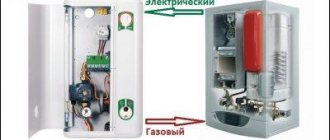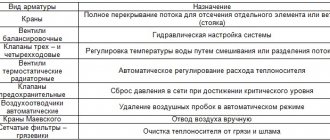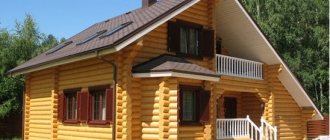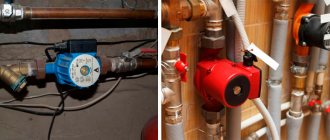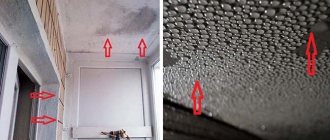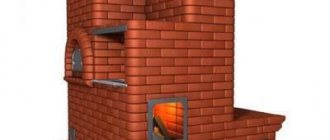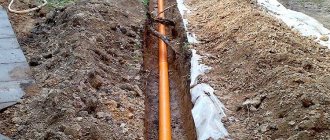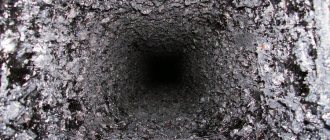No. 1. What should heating pipes be like?
The purpose of heating pipes is clear even to a child. They must transport hot water from the boiler, whatever it is, to the radiators. This is a very important part of the heating system, on the quality of which not only our comfort, but also safety depends.
The following minimum set of requirements is put forward for heating pipes:
- strength and durability. Throughout their service life, the pipes must maintain their integrity. If minor damage occurs and oxygen penetrates through it, the pipes may begin to rust from the inside and become clogged. Large damage will lead to coolant leaks, and this, in most cases, is hot water. The consequences of all this can be catastrophic;
- low noise level during operation , because constantly listening to the sounds of bubbling water is a test for the nervous system;
- aesthetics. It is not always possible to hide pipes in the walls or disguise them, so they should not be frightening with their appearance, much less spoil the interior.
What pipe diameter is suitable for heating in a private house?
The easiest way to determine which pipes are best to choose and what clearance diameter they should be is by simple calculations:
The calculations take into account:
- Flow rate.
- Total thermal load.
- Total living space.
- Climatic features of the region.
What are the standards? According to standardization, with ceilings of 3 meters, heating 1 square meter of a house requires about 100 W of energy. The speed of the coolant (warm water) in the system is within 0.4 - 0.7 meters per second. For a room up to 20 square meters, 2 kW is required, plus 20-30% for losses and external temperature fluctuations. Accordingly, 2 radiators of 1.2 kW are required for each window. But there is also a choice - it is better to install 1 large radiator with a total capacity of 2.4 kW under one of the windows.
The operation of the entire heating system depends on the correct choice of pipe diameter.
Along a cold external wall or on both sides of a large balcony door, preference should be given to vertical radiators with a decorative shield. They are recommended for installation in a children's room. For any type of radiator, pipes with an internal cross-section of 10 millimeters or more are installed, which are easier to wash if necessary.
According to standardization standards, the temperature of the coolant in the heating system for residential buildings should not exceed 90-95°C. Regardless of the choice of pipes for heating a private home, it is important to observe this threshold.
Metal pipes are used for heating systems with gravity (natural) or combined circulation.
Their diameter is selected to match the nozzle of the solid fuel boiler (maximum), then it can be reduced.
Modern boilers have an outlet diameter of up to 50 millimeters, and the return should be the same. After branching, the diameter usually decreases, and closed systems most often have pipes with an internal cross-section of 12.7 millimeters.
Note! The pressure in the heating system of a private household is 2-3 times lower than in urban centralized heating conditions, that is, about 1.5 atmospheres. Under such conditions, any type of pipe is not threatened by water hammer or increased thermal load. Therefore, when choosing a pipe for heating a private house, the owners themselves have the right to decide what is better and more economical to purchase.
No. 2. What to consider when choosing heating pipes?
There are no universal pipes that would function equally well in different rooms. To select the best heating pipes , i.e. the most optimal and suitable in specific conditions, it is necessary to take into account the following factors:
- temperature and pressure in the system , which largely depend on what kind of heating is used, individual or centralized. In individual systems, the pressure rarely exceeds 2-3 atmospheres, and in centralized systems it can rise to 16 atmospheres;
- type of pipe laying , external or hidden;
- total area of heated housing;
- design boiler power and fuel type (for private houses);
- operating conditions of the pipeline. This refers to the presence of unheated premises in certain areas;
- possibility of repairs.
All characteristics of pipes depend on the material they are made of - this is the most important parameter that must be taken into account when choosing.
Selection - criteria
When determining which pipes are best used for heating an apartment or individual house, consider their following physical and operational parameters:
- Corrosion resistance. Since water or antifreeze containing it flows in heating circuits, heating pipes must have high corrosion resistance.
- Strength. The standard pressure in the heating system does not exceed 2 atmospheres; the pipeline should easily withstand this pressure with a margin of 1.5 - 2 times.
- Temperature characteristics. The temperature of the medium in the heating circuit rarely exceeds 70 °C; for heated floors, the limit value is about 50 °C. It is clear that the pipeline must withstand temperature parameters with a reserve in case of emergency situations - overheating of the coolant due to automatic malfunctions, boiler malfunctions.
- Thermal conductivity. Heating pipes transport coolant to radiators or are themselves heat exchangers, transferring thermal energy to the floor screed. In the first case, their thermal conductivity does not play an important role, and its high degree is even undesirable. When working in underfloor heating circuits, on the contrary, high heat transfer is required, so the thermal conductivity of the pipeline must be the highest.
Rice. 2 Extension of a 100 meter section of pipes when heated to 50 °C
- Thermal expansion coefficient. It is well known that all materials expand to one degree or another when heated, this especially affects polymers. If pipes for heating systems are placed on walls or under a bulk screed, it is necessary to take into account this feature of plastics and choose a material with the lowest linear coefficient.
- Difficult to install. To connect pipeline sections, different methods are used depending on the pipe materials; most technologies require the use of special expensive tools and skills to work with them.
There are also methods for connecting plastic pipes with removable compression-type fittings, where the main tool is a regular adjustable wrench. And a little-known novelty in plumbing - a push fitting - allows you to join two sections of cross-linked polyethylene pipes within a couple of seconds with one click.
- Dimensions. During installation, the contour of underfloor heating can be 100 meters or more in length, so it is important that the pipeline used is of the appropriate size to avoid unwanted joints under the screed.
- Chemical resistance. The heating pipeline is often placed in the walls or screed, and antifreeze is passed through it - ethylene glycol, propylene glycol. Therefore, one of the main requirements for the pipeline is resistance to aggressive chemicals.
Rice. 3 The main types of installation of transition fittings on pipes: pressing (for PEX-AL-PEX), PEX compression connection, pressing with a tension coupling (for PEX), PP soldering, pressing of thin-walled stainless steel
- Durability. Heating pipes must withstand long-term operation (according to state standards, at least 50 years), while it should be taken into account that for polymers, the service life is highly dependent on the temperature parameters of the coolant and the pressure in the line.
- Hydraulic characteristics. The inner walls of heating pipes in apartments and individual buildings must have low hydraulic resistance to water flow, that is, be perfectly smooth. This contributes to high system efficiency and reduces operating costs (energy consumption of the circulation pump).
- Breathability. Oxygen present in the coolant is a strong oxidizer of metals; corrosion destroys heating elements, boiler parts and steel fittings in the system. Therefore, it is important that the pipe shell does not allow air to pass through; this requirement is irrelevant for metals due to their high density and is important when using polymer pipelines in the heating circuit.
- Price. The main criterion that people immediately pay attention to when installing heating is that due to their lower price, plastic products are in the highest demand among the population.
It may be useful to read about Connecting the boiler to the heating system
No. 3. Heating pipe material: main types
The following types of heating pipes are used in residential premises:
- steel;
- stainless steel;
- copper;
- polyethylene;
- polypropylene;
- metal-plastic.
Some of them (steel) are already becoming obsolete, others (polypropylene) are just conquering the market, but all of the listed types of pipes are produced and used today, because heating systems are very different and require an individual approach when installing.
Types of pipes for heating systems
Pipes most often used for heating systems are:
- steel;
- metal-plastic;
- polyethylene;
- propylene.
All pipes have their advantages and disadvantages . If you compare them with each other, it is best to consider the performance characteristics using a table.
| Material | Operating temperature °C | Roughness, mm | Pressure loss hPa/m | Coefficient of linear expansion mm/m*deg. |
| steel | 0,07 | 5 | 0,012 | |
| Metal-plastic | 95 | 0,004 | 1,5 | 0,025−0,03 |
| Polyethylene | 90 | 0,007 | 1,8 | 0,15−0,17 |
| Polypropylene | 70 | 0,01 | 2 | 0,15−0,17 |
Metal-plastic pipes have an aluminum layer , with the help of which they tolerate minimal linear expansion and high temperature loads while maintaining their shape. High elasticity allows pipes to be bent as needed.
Polyethylene pipes are heat-resistant , have high joint strength, and low hydraulic losses. It is necessary to choose polyethylene pipes for heating only with a reinforcing layer , which allows the pipe to maintain its shape.
Polypropylene pipes are used if the coolant temperature does not exceed 70 degrees. Due to expansion and high fluidity, this type of pipe requires additional fixation to avoid sagging and malfunctions. If propylene pipes have a reinforced layer of aluminum, then they can be used not only for hidden, but also for conventional wiring.
No. 4. Steel pipes for heating
Until some time, steel pipes were the most popular and practically the only option for organizing a heating system. Time has passed, worthy alternatives have appeared, but steel pipes are still installed, although mainly in private homes. They are made from high quality carbon steel.
Main advantages:
- strength, reliability, high resistance to water hammer, pressure and temperature surges in the system. The material is not afraid of mechanical damage;
- low coefficient of thermal expansion, so you can do without compensators;
- high thermal conductivity;
- Affordable cost is still one of the main reasons for choosing this type of pipe.
Minuses:
- low corrosion resistance. Gradually, the pipes begin to become overgrown, and their capacity drops. Moreover, corrosion processes can lead to leaks and pipe failure. To avoid this, it is recommended to protect the pipe surface by galvanizing;
- large weight and dimensions;
- complex installation. The individual elements are connected into a system by welding. If you do not have the skills to work with a welding machine , then you will need the help of professionals to perform installation work. Welding also means a high probability of damage to nearby objects and surfaces. An alternative option is a threaded connection with separate elements, but thread cutting is no less painstaking and time-consuming. In addition, you will have to deal with numerous couplings, angles and tees, the quality of installation of which determines the main thing - the integrity of the entire system;
- the material conducts stray currents that damage the inner surface of the pipes.
Stainless steel pipes
Stainless steel pipes are a very good replacement for expensive copper pipes, having most of the same positive qualities at a relatively low price.
The advantages of this material are as follows:
- High resistance to pressure (maximum performance is demonstrated by seamless products with thick walls);
- Long service life;
- High thermal conductivity;
- Ability to work at high temperatures (stainless steel pipes can transport even heated steam);
- Excellent strength properties;
- Low cost (relative to copper products).
Stainless steel pipes are available in two forms - seamless products and products with a welded seam. The latter are made by welding and are sheet steel rolled into a pipe. The price of such products is lower, but you have to pay for it with a shorter service life.
Understanding which steel pipes are better for heating, you can come to a clear conclusion - these are seamless pipes that demonstrate the best qualities. Products with thin walls are almost equal in performance parameters to copper ones - and the difference in price is more than noticeable.
No. 5. Stainless steel pipes for heating
Corrugated pipes made of alloy stainless steel do not have many of the disadvantages of their steel counterpart. They are used to install heating systems in new houses, as well as to reconstruct the heating system in old ones; they have gained great popularity in the installation of heated floors, hot and cold water supply. Such a wide scope of application is explained by the main feature of this type of pipe – the ability to bend.
Advantages:
- Stainless steel corrugated pipes are resistant to corrosion, do not collect scale on the walls, and are durable;
- resistance to water hammer and external mechanical influences;
- slight thermal expansion;
- flexibility, and such a pipe bends practically without reducing the internal diameter. This is convenient when space for installing a heating system is limited. In addition, complex systems can be installed with a minimum number of connections. This feature has made stainless pipes very popular when installing water-heated floors;
- high heat transfer;
- relatively simple installation;
- wide scope of use.
As you might guess, there is only one disadvantage - the cost, but it pays off in durability and ease of installation . Another unpleasant feature is the low durability of the sealing rings, about 30 years.
Finned products
Video: review of finned tubes for heating systems
Finned tube - keep the pigs warm
Finned pipes have a high heat transfer coefficient, therefore, they are indispensable for heating. By making the surface finned, they achieve greater efficiency in heat transfer by increasing the surface in contact with air. And heat transfer in this case is 50% higher.
Let's look at their technical characteristics:
- diameter within 8 – 100 mm.
- Wall thickness from 0.2 – 12 mm.
- Rib thickness from 0.8 – 2.5 mm.
- Rib height level from 8 to 30 mm.
- Type of fins. It can be different. The easiest way is to weld aluminum tape to the surface. This tape is also pressed onto the workpiece and rolled on a machine. They also use steel tape, it is wound and welded.
The price of ribbed goods depends on the thickness of the product itself, on the length of the transverse rib and on the material used for manufacturing. The cost of finned products is also affected by the presence of a coating with a heat-resistant composition.
This range is characterized by great rigidity and internal strength, for these reasons they can withstand maximum loads over a long period of time. Finned tube can handle temperatures up to 350 degrees, while welded steel strip options can withstand higher temperatures better.
Video: what are the best materials to choose for heating systems
How to choose polypropylene pipes for heating
No. 6. Copper pipes for heating
Let's continue our study of metal heating pipes. Copper pipes began to be used back in the 17th century and are still actively used today, despite the emergence of cheaper options.
Advantages:
- durability, compared with the service life of buildings. Copper pipes and fittings do not lose their quality for 100 years or more;
- resistance to corrosion, high tightness, lack of ability to allow air to pass through and accumulate deposits on the inner surface, so the throughput of pipes does not decrease over the years;
- high thermal conductivity;
- resistance to temperature changes (operating temperature range from -200 to +5000C) and pressure surges in the system;
- aesthetic appearance.
The main disadvantage is the high price . Not only is the material itself expensive, but also the main manufacturers are concentrated outside the country. If we take into account the durability of the material and the absence of problems in the next 100 years, then the cost does not look like such a significant drawback. If the issue of choosing heating pipes does not depend on the budget, then copper pipes will be the best option. The installation process is specific, so it is better to seek help from professionals.
In order for the heating system to last for many years, it is better not to combine copper pipes with unalloyed steel . The latter will rust very quickly. If such a combination cannot be avoided, then let the steel pipes be in front of the copper pipes in the direction of water movement.
Calculation methods
How to calculate the diameter of heating pipes? There are several methods:
- According to special tables. However, their use still requires preliminary calculations: the power of the heating system, the speed of movement of the coolant, as well as heat loss along the main line.
- By thermal power.
- According to the resistance coefficient.
What you need to know to calculate
To carry out the calculation you will need the following data:
- Heat demand (thermal power) of the entire house and each room separately;
- The total power of the heating devices used (boiler and radiators).
- Thermal load on individual sections of the circuit.
- The total heat loss of the house and each room separately during the coldest winter period.
- Resistance value. It is determined by the wiring diagram, the length of the line, the number and shape of bends, connections, and turns.
- The total volume of coolant loaded into the heating main.
- Flow speed.
- Circulation pump power (for forced heating).
- Line pressure.
Calculation of pipe cross-sections for heating systems with forced air circulation:
Calculation procedure
- Calculation of required thermal power.
- Determination of the circulation rate of the carrier in the heating system.
- Calculation of heating circuit resistance.
- Calculation of the required pipeline cross-section.
- Calculation of the optimal diameter of the heating collector (if necessary).
Calculation of system thermal power
Method 1. The simplest way to calculate thermal power is based on the established standard of 100 watts per 1 m² of room. Those. with a house area of 180 m², the power of the heating circuit will be 18,000 watts or 18 kW (180 × 100 = 18,000).
Method 2. Below is a formula that allows you to adjust the data taking into account the power reserve in case of severe frosts:
However, these methods are characterized by a number of errors, because does not take into account the range of factors influencing heat loss:
- ceiling height, which can vary in the range from 2 to 4 or more meters, which means that the volume of heated rooms, even with the same area, will not be constant.
- the quality of insulation of the house facade and the percentage of heat loss through external walls, doors and windows, floor and roof;
- thermal conductivity of double-glazed windows and materials from which the house is built.
- Climatic conditions of the regions.
Method 3: The method presented below takes into account all the necessary factors.
- The volume of the entire house or each room separately is calculated using the formula:
V = h×S,
Where:
- V – Volume of the heated room.
- h – Ceiling height.
- S – Area of the heated room.
- The total power of the circuit is calculated:
The following formula is often used:
In this case, the regional correction factor is taken from the following table:
The heat loss correction factor (K) directly depends on the thermal insulation of the building. It is customary to use the following average values:
- With minimal thermal insulation (typical wooden or metal structure made of thin sheets), a coefficient in the range from 3 to 4 is taken into account;
- Single brickwork - 2-2.9;
- Average level of insulation (double brickwork) – 1-1.9;
- High-quality thermal insulation of the facade - 0.6-0.9.
Water speed in pipes
The uniformity of the distribution of thermal energy among the elements of the circuit depends on the speed at which the liquid moves, and the smaller the diameter of the pipeline, the faster it moves. There are speed limits:
- not less than 0.25 m/sec, otherwise air pockets will form in the circuit, preventing the movement of the coolant and causing heat loss. If the pressure is insufficient, the air plugs will not reach the installed Mayevsky valves and air vents, which means they will be useless;
- no more than 1.5 m/sec, otherwise the media circulation is accompanied by noise.
The reference flow rate is from 0.36 to 0.7 m/s.
This should be taken into account when choosing the appropriate pipe section. By installing a circulation pump, it becomes possible to control the circulation of coolant in the circuit without increasing the diameter of the pipeline.
Calculation of heating circuit resistance
When calculating the cross-section of pipes using the resistance coefficient, the first step is to determine the pressure in the pipeline:
Then, by substituting the pipe diameters, the minimum heat loss value is selected. Accordingly, the diameter that will satisfy acceptable resistance conditions will be the desired one.
Heating manifold calculation
If the heating system provides for the installation of a distribution manifold, then determining its diameter is based on calculating the cross-sections of the pipelines connected to it:
The distance between the collector pipes should be equal to triple their diameter.
No. 7. Polypropylene pipes for heating
Polypropylene pipes are made from polymers; there are several types of such pipes, but PPs pipes made from special propylene are usually used in heating systems. Materials from the thermoplastic group, which include all types of polypropylene pipes, are unstable to high temperatures, so for heating systems it is necessary to use only reinforced pipes, preferably with fiberglass . For example, pipes of type PN25 are reinforced and can withstand system pressures of up to 25 atm and temperatures of +950C with a short-term increase to +1200C.
Advantages:
- relatively long service life. According to the manufacturers, durability reaches 50 years;
- corrosion resistance. The inner surface of the pipes remains smooth throughout the entire service life, without compromising the throughput. Due to the tightness, oxygen does not pass into the system and does not damage its metal elements;
- high mechanical strength;
- light weight;
- resistance to low temperatures. If water is frozen in a pipe, you don’t have to worry about its integrity - thanks to its ability to expand, the material will not be damaged and will return to its original shape after thawing;
- hermetic connection, which is ensured by special fittings and welding;
- relatively simple installation process. To connect individual elements with fittings, a special welding machine is used, which is popularly often called an iron and a soldering iron. It takes a few seconds to weld a joint, and learning how to operate the machine is not difficult;
- low noise level when water moves through pipes, especially when compared with metal analogues;
- completely harmless to health;
- relatively low price. Polypropylene pipes will cost less than metal-plastic or stainless steel ones.
Among the disadvantages:
- inability to use in fire hazardous areas;
- high linear expansion results in the need to use compensators.
Disadvantages often include low heat resistance, low rigidity and instability to water hammer. This is due to the incorrect choice of polypropylene pipes. Heating systems require only reinforced products that do not sag and can withstand high temperatures and pressure. In addition, the production process is of great importance: if the technology is violated, pipes of inadequate quality come out, so it is better to give preference to proven, reputable manufacturers.
Classification
To avoid problems during the assembly and operation of the pipeline, you need to choose the right material from which the individual elements are made. Types of heating pipes:
- made of metal - different types are used;
- made of plastic (polypropylene);
- made of metal-plastic (a combination of two materials).
Metal
Types of metal heating pipes:
- steel;
- copper;
- made of stainless steel.
Advantages of steel:
- Resistant to water hammer and high temperatures.
- Durability, wear resistance.
- High thermal conductivity.
- Thermal expansion is low.
Flaws:
- Low resistance to rust formation.
- Heavy weight.
- Conductivity of stray currents.
- Difficulty in installing individual elements.
Benefits of copper:
- Durability.
- High thermal conductivity.
- Resistant to rust formation.
Copper parts have no serious disadvantages. However, the technical characteristics of this material are determined by its high price.
Advantages of stainless steel:
- Rust resistant, durable.
- High thermal conductivity.
- Resistant to pressure surges and temperature changes.
- Low thermal expansion.
The disadvantage of stainless steel parts is their high price.
Advantages of steel pipes:
- Acceptable cost
- High resistance to high temperatures
- High pressure resistance
- And of course, greater stability both on straight sections and on rounded sections.
Flaws:
- Their installation is very expensive and requires expensive equipment with the participation of highly qualified specialists.
- In addition to all of the above, steel is quite heavy and bulky. Therefore, you will definitely need help during installation. In this case, it is desirable to have the skills of welders and assemblers.
- When installing an internal heating system, steel pipes are not at all suitable. Steel is very susceptible to corrosion and therefore replacing individual parts of the heating system will be very costly and energy-intensive.
Polypropylene pipes
The main advantage of polypropylene pipes is their low cost.
The ease of installation, which you often hear about, is quite relative. Firstly, installation will require the use of a special welding machine. The device is quite expensive and requires certain operating skills.
Secondly, with polypropylene it is almost impossible to check the quality of the welded joint, which, meanwhile, depends on many parameters. From the qualifications of the master, the condition of the welding machine, the correct heating temperature, and holding time.
Note! Insufficient exposure can eventually cause a leak, and excessive heating can melt the inner layer of plastic and reduce the throughput of the pipeline.
Another disadvantage of a polypropylene pipeline is linear extension. Even reinforced products can noticeably elongate when heated, which often leads to changes in the configuration of the pipeline.
We recommend that you read: What is the difference between HDPE corrugation and PVC and which is better to choose?
For this reason, polypropylene is not recommended for use in projects that involve pouring pipework into a screed.
It is worth remembering that not every type of polypropylene pipe is suitable for a heating system:
- First type. Marking PP-H. Not intended for networks with high media temperatures. It is mainly used in ventilation and cold water supply systems.
- Second type. Marking PP-B (PP-2). Often used in networks with low media temperatures, for example, underfloor heating systems.
- Third type. Marking PPRC (PPR, PP-3). Resistant to compression and high temperatures. Best suited for the construction of heating systems.
Plastic
Advantages of plastic:
- Durability - 50 years.
- Resistant to rust.
- Low price.
- System tightness.
Disadvantages of plastic:
- For installation you need to buy additional equipment.
- High temperatures destroy the material.
- Low thermal conductivity.
Advantages:
- Special impact resistance can be highlighted.
- Increased gas tightness, wear resistance and lack of electrical conductivity. Thanks to these properties, copper pipes are used not only in the industrial sector, but also when installing individual heating systems.
- The main advantage of polypropylene pipes for heating is their low cost and weight. These advantages allow you to install such pipes alone.
- The manufacturing method implies an almost smooth inner surface. This eliminates the formation of lime deposits that impede the circulation of the coolant.
- Soldering polypropylene pipes does not require specialist intervention or special equipment.
- The service life without loss of efficiency is 25 years.
- Increased resistance to low temperatures.
- Neatness and good appearance.
The disadvantages include:
- Hardness of polyvinyl chloride. In the future, this can lead to sagging of the entire system, resulting in a break or crack. As a result, for repairs you will have to not just repair a section of the pipe, but replace the entire section between the fittings.
Metal-plastic
Advantages of metal-plastic:
- Service life - 50 years.
- Stray currents are not transmitted through metal-plastic.
- High tightness.
- Resistant to rust.
- Durability is higher than that of plastic.
- You can bend parts to create complex shapes.
We recommend: Grounding a gas boiler in a private house: standards, arrangement and testing methods
Flaws:
- Weak resistance to UV rays.
- Destruction of material from exposure to high temperatures.
- High price.
The main advantages of metal plastic.
- Minimal expansion of the material, which does not lead to deformation of the entire system
- The smoothness of the inner walls prevents the formation of deposits
- Optimal heat resistance. Compared to metal and plastic.
- Resistance to kinks and tears
- Light weight
- Corrosion resistance
- Simple processing without the use of special skills and equipment.
The disadvantages include:
- Not too long service life. Up to 15 years old.
- And the considerable cost of connecting parts - fittings.
Alloy steel pipes.
Alloy steel pipes are very durable because, in addition to standard impurities, they contain various additives that improve their physical properties. The best example of alloy steel pipes is stainless steel pipes. They contain a certain amount of chromium, which ensures their anti-corrosion. In addition, they are easily processed with special tools. Heating pipes made of alloy steel are much lighter than conventional steel ones. They also have increased resistance to temperature and mechanical stress. And they can serve perfectly at pressures up to 15 bar. Another advantage of these heating pipes is their ability to transport not only liquid, but also gaseous coolants.
No. 8. PEX pipes or cross-linked polyethylene pipes
Due to a special production technology, new molecular bonds appear in the structure of polyethylene, which provide additional strength and other useful properties. Today, such pipes are used not only in heating systems, but also in the installation of heated floors, as well as in the arrangement of hot water supply systems.
Advantages:
- corrosion resistance;
- strength along with sufficient flexibility;
- durability up to 50 years;
- ability to withstand coolant temperatures up to 1200C, temperature and pressure changes;
- light weight.
Among the disadvantages , we highlight the high price of the pipes and fittings themselves and the need for special equipment for installation, so they are used quite rarely.
The influence of pipe type and size on system performance
Is the pipe diameter really that important? As practice shows, extremely! A number of factors that ensure high efficiency of the entire circuit depend on it:
- Throughput and heat transfer coefficient. Those. the total volume of coolant located in the main during a certain period of time and subject to heating.
- Coolant pressure in the circuit, temperature and speed of its movement.
- Hydraulic losses that occur at the junctions of pipes and elements of different sections. The more such transitions, the greater the losses.
- Noise level of the heating system.
There are several types of diameter:
- External. Takes into account the cross-section of the internal cavity and the thickness of the pipe walls. Used when designing a heating system.
- Interior. Reflects the cross-sectional value of the internal cavity of the pipe. Determines the throughput of the pipeline.
- Nominal (conditional). Represents the average value of internal diameters obtained as a result of calculations.
In order for the heating system to work fully, in addition to the pipe cross-section, a number of other factors should be taken into account:
- Properties of the coolant, which is water, antifreeze or steam.
- The material from which the pipes are made.
- The speed of the coolant.
- Type of heating system: one- or two-pipe.
- Type of circulation: natural or forced.
No. 9. Metal-plastic pipes for heating
Many people call metal-plastic pipes the most balanced in terms of price/quality ratio. Such popular love has serious grounds. The product is made on the basis of polyethylene and aluminum foil: the outer and inner layers are plastic, in the middle there is foil, which plays the role of a frame and gives rigidity to the structure, and binds all layers with glue with high adhesion to metal and plastic. This structure allows us to talk about a lot of advantages :
- resistance to corrosion, because the coolant is in contact only with plastic;
- the inner layer is smooth and does not accumulate deposits;
- tightness and oxygen impermeability, so the metal parts of the system will be safe;
- the material bends well, so you can easily create an effective heating system even in rooms of complex configuration. Moreover, they sell pipes in coils of 50-500 m, so with one piece you can build a heating system in large spaces, and the fewer connection points, the less likely it is to leak;
- durability up to 50 years;
- relatively simple installation;
- the material does not transmit stray current.
Minuses:
- instability to mechanical loads and open fire;
- low resistance to ultraviolet rays, so it is better to use protection in the form of a corrugated pipe;
- the price is twice as high as for polypropylene pipes.
It is also worth noting such a property as the absence of linear expansion . On the one hand, you can safely embed pipes into the walls without fear of damaging the future finish. On the other hand, if the coolant freezes, the material will not withstand the load and will tear. This is a good option for permanently heated visits.
The elements can be connected using a detachable, conditionally detachable or one-piece fitting. The latter requires special, expensive equipment, and when installing a threaded fitting, great care is required, since the nut can damage the pipe.
Choosing pipes: where to start?
Currently, there is no shortage of pipes in stores of all possible types, materials, sizes and countries of origin. Of course, a huge selection provides significant advantages when selecting pipeline elements, but it is easy for a master who is faced with this task for the first time to get confused.
It is worth considering that it is usually pointless to seek help in the stores themselves and from various kinds of consultants: they will advise either something that costs more (explaining the inflated price as good quality), or a product that has been in stock for a long time, which is time to get rid of. Therefore, you still need to figure it out on your own.
For a private house, there are three heating options: connecting the building to city communications, creating an autonomous circuit, or a mixed option. In the first case, the design of heat supply occurs according to general rules, in the second and, partly, in the third, according to an individual scheme.
Heating pipes for a private house are selected incorrectly if:
- their diameter does not meet the network requirements;
- the developed system does not cover all housing;
- the size or number of products does not correspond to the operating power of the heating boiler;
- they do not match the type of fuel used.
In addition, a common cause of cold in the house is inaccurately executed thermal insulation.
In general, any heating circuit for individual housing can be one of two types:
- Closed.
- Hidden.
Depending on the selected type of circuit, pipes are selected that correspond to the expected temperature conditions of the operating heating system and seasonal temperature changes.
To ensure the most comfortable living conditions, built-in pipes should be laid:
- Along the outer perimeter of the building.
- Inside the house, including under the floor.
It is possible to install an autonomous heating circuit in multi-apartment buildings, and in the work you can use the same consumables and design schemes as in private buildings.
The only thing you should remember when deciding which pipes are best for the heating system is regular hydraulic overloads when starting heating in the autumn. It is worth noting, however, that most modern products withstand this test well.
No. 10. So which heating pipes are best to choose?
If you plan to install the entire heating system yourself, then it is better to take polypropylene pipes . They are cheap, all connections are completely sealed, and even those with minimal construction experience can quickly learn how to use a special welding machine for polypropylene. More time will be spent not on installation, but on calculations and preparatory work. The main thing is to purchase fiberglass-reinforced polypropylene pipes and stainless steel taps, and the entire system will work long and reliably.
Metal-plastic pipes are also a good option. Although they are more expensive, installation does not require any specific tools - only a wrench, but the connection risks losing its tightness over time.
If you have the means, stainless steel pipes are a good option . Copper pipes will cost even more, but they are worth it.
Skirting profile HZ
HZ skirting profiles for heating pipes are considered a convenient option for laying communications. This is a detailed coordinated system that consists of fasteners, a profile that has a decorative function, connecting units of heating equipment, etc.
The use of these systems makes it possible to cast an interfloor ceiling without a leveling screed, where previously a large number of communications were hidden.
Some may argue that this is expensive, but the cost of concrete in this situation is no less. And taking into account concrete work, it can be much more expensive. And another advantage in favor of the plinth profile is the fact that communications can be reached without causing damage to the interior.
The obvious advantage of HZ skirting profiles is obvious: there is no need to punch through channels in the walls, after this there is no large pile of garbage in the house, which means there is no longer a large “front” of construction work, which means money is saved.
The pipeline is laid parallel to the floor and lined with a plinth profile. You can lay not only pipes in it, but also electrical cables.
The profile itself and its fasteners are made from durable, heat-resistant, environmentally friendly plastic. This material is also characterized by dynamic strength.
In order to level out small irregularities on the walls or floor, the profile is equipped with a flexible edge that exactly repeats the shape of the surface with which it is mated.
Brackets
Brackets for heating pipes are an indispensable element during installation. This item has become very popular due to its large assortment and affordable price. Here you also need to add the ease of installation and wide functionality.
To secure a pipeline of medium diameter, you can use clamps, and for small diameters, brackets or hangers are used as fasteners. In technical literature there is often an identification between a clamp and a bracket, but in reality the clamp is the main fastening part of the bracket.
The classic bracket for the heating pipeline consists of two parts that are bolted together. And it is attached to the wall using a dowel. To prevent surface deformation and ensure a strong fixation, use a rubber gasket.
Valtek products
Valtek heating pipes are manufactured by an Italian company that was founded in 2002. In an extremely short period of time, Valtek products have conquered the building materials market.
This company produces polypropylene pipe products using the latest technologies and modern materials. Each stage of manufacturing Valtek products occurs under strict control, and any errors or deviations from standards are excluded.
Video: Valtek products
Polypropylene pipes and fittings VALTEC
The advantages of Valtek products are as follows.
- Increased strength.
- Resistance to corrosive formations.
- Light weight.
- Easy installation.
- Long service life.
Despite the wide range of advantages, these options have some disadvantages, and they are as follows:
- Processing with a trimmer is required.
- Mandatory adherence to permissible limits of temperature and pressure.
When purchasing Valtek products, you should carefully study the documents for them; there are offers on sale of dubious quality (many fakes have appeared), and it is impossible to determine this by appearance.
Video: heating pipes and their review
Heating pipes
Using a thermometer for heating communications
A thermometer for heating pipes is necessary to measure the temperature in the heating network. For her, these indicators are very important. In cases with heating devices, you simply cannot do without this data.
As practice shows, the mechanical thermometer is most widely used in these highways. The principle of its operation is based on the property of metal to shrink and expand at different temperatures.
Bimetallic thermometers are an ideal means for monitoring temperature, because they react to temperature changes instantly. These instruments have an easy to use dial. It is very convenient for home use. Such thermometers are made from two types of metal, and this is evidence of their reliability.
These devices have gradually replaced liquid options that operate on the properties of liquids. Mechanical thermometers have proven themselves to be very reliable and durable. According to the installation form, thermometers can be axial or radial.
Video: Digital thermometers and their errors
Digital thermometers and their errors.
It is also necessary to say separately about a new product – a pipe thermometer. It is attached to the pipeline by means of a spring, which presses it against the pipeline.
Arranging a heating system: choosing a boiler
The advantages of a private heating circuit are obvious: there is no need to pay inflated tariffs to the management company, you can forget about surcharges for operating the heating main and other unpleasant and unnecessary expenses.
The heart of an individual heating system is a heating boiler. Such devices are expensive, but after several years of uninterrupted service they more than pay for themselves.
The main types of boilers are as follows:
- solid fuel boiler;
- a gas boiler;
- combination type device.
Regardless of the type chosen, these devices give the owner the opportunity to:
- at your own discretion, set the desired heating temperature at home;
- save on fuel by reducing power or turning off the boiler altogether;
- reschedule the number of radiators in the home;
- flush the heating circuit independently, without notification or calling specialists;
- by your decision to begin and end each heating season without suffering from cold in the fall or excessive heat in the spring.
